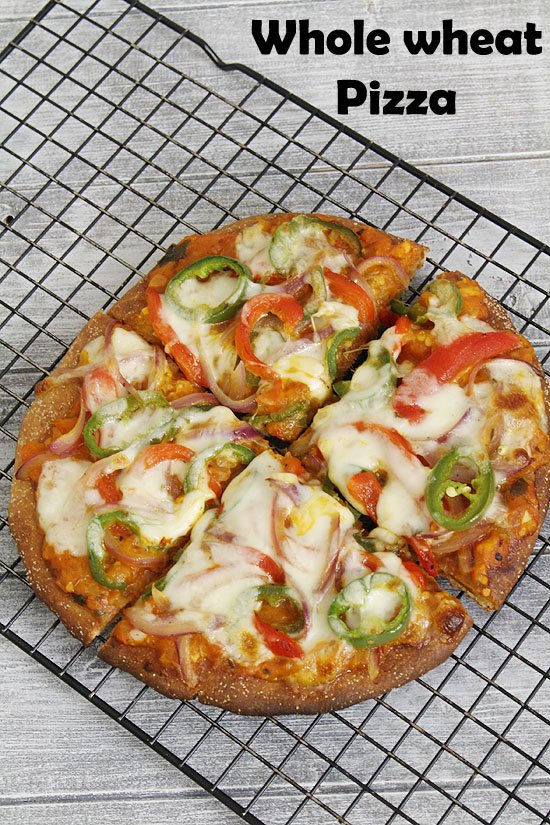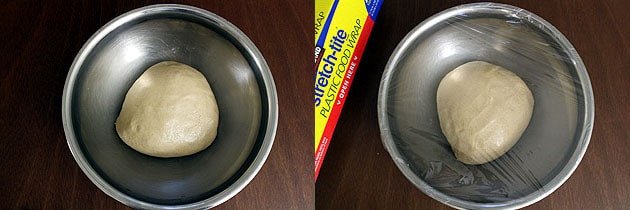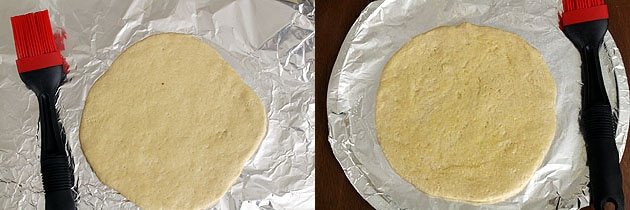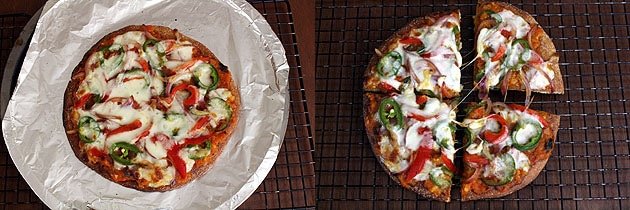This wholesome pizza is made using whole wheat flour, also known as chapati atta, making it a healthier alternative to the traditional all-purpose flour (maida) crust. The result is a soft and airy base with perfectly crisp edges—light, satisfying, and much better for you.

Unlike the classic veg pizza I’ve shared earlier that uses maida, this version uses 100% whole wheat flour to prepare the dough. Brushing the outer crust with olive oil before baking adds a beautiful golden hue and a slight crunch.
While the dough is resting and rising, you can prepare a quick homemade pizza sauce using fresh tomatoes. The sauce comes together in just 20 minutes and brings a rich, natural flavor to your pizza.
For the toppings, I’ve gone with a mix of onion, jalapeño, and flame-roasted red peppers. To roast the red pepper, place it over an open flame until the skin is blackened and charred on all sides. Once cooled, peel off the burnt skin, remove the stem and seeds, and slice into thin strips.
You can get creative with the toppings based on what you like or have on hand—options like sweet corn, bell peppers (capsicum), mushrooms, olives, or even paneer work wonderfully. This homemade atta pizza is not just delicious but also a nutritious way to enjoy your favorite comfort food.
Ingredients
For the whole wheat pizza dough recipe:
- Whole Wheat Flour – 3 cups: Use regular chapati atta to make this dough. It brings a mild, earthy taste and boosts the fiber content, offering a more nutritious and hearty alternative to traditional all-purpose flour.
- Instant Dry Yeast or Active Dry Yeast – 2¼ teaspoons (1 packet): Either yeast works well. Active dry yeast needs to be dissolved in warm water to activate before mixing it into the flour, while instant yeast can be added straight to the dry mix.
- Olive Oil – 2 tablespoons: Adds richness and moisture to the dough. It also improves texture and makes the crust tender on the inside and slightly crisp on the outside.
- Salt – as needed: Enhances flavor. Adjust the quantity to your taste, usually around 1 to 1½ teaspoons.
- Honey – 1 tablespoon: A natural sweetener that helps balance the wheat flavor and also supports yeast fermentation for a light and airy dough.
- Warm Water – 1¼ to 1½ cups: Use lukewarm water—not hot—to help the yeast activate properly and to combine the dough ingredients smoothly. Start with 1¼ cups and add more if needed while kneading.
For the pizza recipe:
- Pizza Sauce – ½ to ¾ cup: Use your favorite homemade tomato-based sauce. Freshly made sauce from ripe tomatoes works best for depth of flavor. Adjust the quantity based on how saucy you prefer your pizza.
- Olive Oil – 2 to 3 tablespoons: For brushing the pizza base before baking. This helps to get a beautiful golden-brown crust and prevents the base from becoming soggy.
- Red Onion – 1 medium, thinly sliced: Adds a slight sweetness and crunch. Slice thinly so it cooks evenly in the oven.
- Jalapeños – 3 to 4, sliced: These bring a mild heat and enhance the overall flavor. Feel free to modify the amount to match your preferred spice level.
- Red Bell Pepper – 1 medium, roasted and sliced: Char the red pepper over an open flame until the skin blackens. After it cools down, gently remove the charred skin, discard the stem and seeds, and slice the pepper into thin strips. This adds a smoky, sweet flavor.
- Mozzarella Cheese – 2 cups, shredded: Opt for high-quality mozzarella to achieve that perfect melt and signature cheesy stretch that makes every bite of pizza irresistible. You can mix with a bit of cheddar or parmesan for extra flavor if you like.
How to make a whole wheat pizza: Step by Step Instruction:
1) Add whole wheat flour, salt, honey, and olive oil to a food processor equipped with a dough hook, and begin blending to create the base for your pizza crust. You may also use a stand mixer or knead the dough manually.
Note:
If using instant yeast, simply stir it into the flour without any prior activation.
If using active dry yeast, dissolve it in warm water (not hot) and let it sit for 10–15 minutes until frothy. Then use this activated mixture to knead the dough.
2) Pulse to combine: Use short bursts to mix until the ingredients come together into a rough, crumbly dough.

3) Gradually add water: Begin with a smaller amount of warm water and continue to add as needed, pulsing between additions, until the dough starts coming together.
4) Knead until smooth: Continue running the food processor until the dough becomes soft, elastic, and smooth. If kneading by hand, this will take about 10–12 minutes of firm kneading. A well-kneaded dough ensures a fluffy, airy pizza crust. Under-kneading may lead to a dense base.

5) Let the dough rest: Lightly oil a large bowl and place the dough inside, turning it so it’s coated with oil. This prevents drying. Cover the bowl with cling film or a clean cloth to keep the dough from drying out during rising.
6) Allow the dough to sit undisturbed in a cozy, warm spot for about 1.5 to 2 hours, until it visibly puffs up to nearly twice its original size.

7) Prepare the sauce: As the dough rests, take the time to make your fresh tomato-based pizza sauce, if you haven’t done so already. It’s best when simmered with herbs and spices for 15–20 minutes.
8) Prepare the toppings: Meanwhile, slice the vegetables—onions, jalapeños, and roasted red peppers—and shred the mozzarella cheese so everything is ready for assembly. Keep everything ready for assembly.
9) Preheat the oven: Just before shaping the pizzas, preheat your oven to 450°F (230°C). Let it heat for at least 15 minutes to ensure it’s evenly hot.
10) Prepare your baking tray: Line a baking sheet with aluminium foil or parchment paper. Brush the tray with a thin layer of oil to avoid sticking, then keep it ready for use.
11) Check the dough: After rising, the dough should be soft and puffed. Gently press the dough to release any built-up air and prepare it for shaping.
12) Portion and shape: Divide the dough into three equal pieces. Shape each dough piece into a smooth ball, then roll it out into a 6-inch disc with moderate thickness.

13) Brush a thin layer of olive oil over each rolled crust to help it turn golden and bake up with a crisp texture.
14) Place the rolled dough onto the greased baking tray, making sure the side brushed with oil faces down.

15) Prebake the base: Bake the crust in the preheated oven for 7–8 minutes. You’ll notice the bottom turning golden brown and slightly firm—this step prevents a soggy base.
16) Spread sauce: Remove the prebaked crusts and spread 3–4 tablespoons of your prepared sauce evenly over each one.

17) Add toppings: Distribute the sliced vegetables across the pizzas, making sure they’re spread out evenly for consistent flavor in every bite.
18) Add cheese: Top the pizzas with shredded mozzarella. Be generous but ensure it’s evenly distributed.

19) Final bake: Return the assembled pizzas to the oven and bake for another 6–7 minutes, or until the cheese is melted and bubbly with golden spots.
20) Serve hot: Remove the pizzas from the oven, transfer them to a wire rack for a minute or two, then slice and serve warm.

Expert Tips for the Perfect Whole Wheat Pizza
1. Use Fresh Ingredients
Fresh yeast, vibrant veggies, and quality cheese make all the difference. Avoid wilted vegetables or stale cheese, as they can impact the flavor and texture of the pizza.
2. Don’t Overload the Toppings
Adding too many toppings might seem appealing, but it can lead to a soggy crust that doesn’t bake evenly. Keep it balanced for the best results. Spread your toppings evenly and use just enough for balanced flavor in every bite.
3. Let the Dough Rest
Allowing the dough to rest and rise properly helps develop flavor and results in a light, fluffy texture. Be patient and let it rise until doubled in size—rushing this step will give you a dense crust.
4. Bake on High Heat
A preheated oven at high temperature (around 230°C or 450°F) mimics the conditions of a pizza oven. This helps the crust puff up and get crispy on the outside while staying soft inside.
5. Pre-bake the Base
Baking the pizza base for a few minutes before adding the sauce and toppings prevents a soggy crust and helps it hold its shape better.
6. Grate Cheese Fresh
Pre-grated cheese usually has anti-caking additives that hinder smooth melting. For best texture and flavor, grate fresh cheese at home. Grating your cheese fresh at home ensures a smoother melt and richer flavor.

Serving suggestion:
Relish this wholesome veg pizza as a satisfying meal in itself. Made with whole wheat flour, the crust is heartier and denser than traditional refined flour bases, offering a more filling and nourishing experience. Because of its rich, fibrous texture, this pizza tends to be slightly heavier on the stomach. To balance it out, consider pairing it with a refreshing beverage—freshly squeezed fruit juice adds a natural sweetness that complements the savory flavors, while a fizzy drink offers a fun, contrasting sparkle. Whether you’re enjoying it for lunch, dinner, or even at a casual gathering, this whole wheat pizza makes for a deliciously balanced and wholesome treat.
